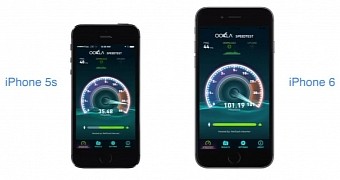Pitting two iPhones in a speed test is always fun. Especially when there’s a one-year difference between them, essentially one generation in smartphone years.
For those of you who are curious to see how the LTE speeds of the iPhone 6 and the iPhone 5s compare, iClarified has put together a 2-minute video (embedded below) showing the upload and download speeds of the two phones on a 4G network in the city.
LTE Advanced
Apple is not kidding when it comes to the cellular speed of the iPhone 6. According to the test, the iPhone 6 can effortlessly reach speeds over 90 Mbps, while their highest download speed recorded was 111 Mbps. By comparison, iPhone 5s reached speeds of around 35 Mbps.
The company’s marketing of the iPhone 6’s wireless capabilities reads, “A superfast connection can make you feel like the whole world is within reach. That’s why iPhone 6 has faster LTE download speeds.”
“That’s also why it has more LTE bands than any other smartphone. iPhone 6 supports more advanced wireless technologies to boost performance and help you connect to the things — and people — that matter most,” it adds.
Apple touts speeds of “up to 150 Mbps,” which is what the iPhone 6 can do with its all-new Qualcomm MDM9625M LTE Advanced chip.
The device further supports Voice over LTE (VoLTE), which is used for wide-band high-quality calls that sound much clearer.
Other wireless perks
Apple confirmed during its September 9 event that the iPhone 6 would offer support for up to 20 LTE bands, making it a very attractive choice for users worldwide. Whatever carrier you’re on, chances are the iPhone 6 supports their version of LTE.
“That means iPhone users can connect to more high-speed LTE networks in more places. And when you’re traveling, more LTE bands help you benefit from the growing number of roaming agreements around the world,” the company notes.
As far as the phone’s Wi-Fi radios go, users get 802.11ac, a standard also referred to as Wi-Fi 5G. It’s supposedly around three times faster than the 802.11n standard, which is the de-facto Wi-Fi on most devices today.
Users can employ that Wi-Fi capability to even make calls using their own number, Apple also revealed last month. The feature will come in extremely handy when the cellular signal is poor or absent altogether.
When the Wi-Fi connection is out of range or interrupted, VoLTE switches back on automatically and lets you continue the call without hiccups.

 14 DAY TRIAL //
14 DAY TRIAL // 